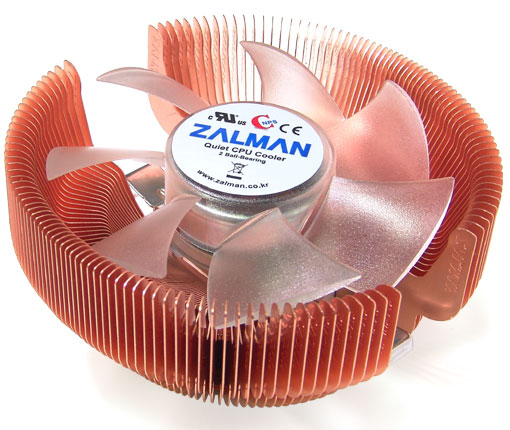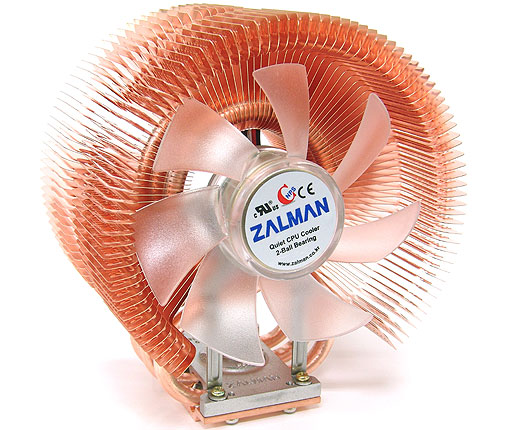The Zalman Twins: 9500 & 9700 Air Tunnels
by Wesley Fink on February 19, 2007 12:40 AM EST- Posted in
- Cases/Cooling/PSUs
Zalman is a name that instantly comes to mind with Computer Enthusiasts when cooling is mentioned. However, Zalman built its reputation with low-noise products and not with high performance. Silence and Zalman go hand-in-hand, but that is not normally the same as best performance. Zalman is a company that builds an exotic fanless power supply, a fanless GPU cooler, the Reserator 2 fanless water-cooled case, and huge copper fin CPU coolers with large, low-speed fans for cooling.
To be frank, Zalman most likely is the reason for the current fashion of large fans running at slow speeds, which has proven to provide superior cooling with much lower noise than smaller fans running at high speeds. A South Korea based company, Zalman has quickly grown in the past few years from a "good-idea" product to a huge product line based on the silent or low-noise cooling concept. With the growth have come additional offices, with US offices located in Garden Grove, California.

The CNPS9500 and CNPS9700 families are roughly based on the current thinking about heatpipe tower cooling - with a Zalman twist. From the very first Zalman coolers a few years ago, we have seen huge multi-finned circular coolers with a large, proprietary contained cooling fan. The CNPS7500 you see above is a good example of the typical Zalman CPU cooler.

Last year Zalman introduced an update to this concept in the Zalman CNPS9500. The 9500 turned the large orb on its side, supported by looped heatpipes that claimed the efficiency of a six heatpipe design. Zalman had their version of the increasingly popular and effective heatpipe tower.

A few weeks ago at CES, Zalman introduced a larger version of the 9500 which they call the CNPS9700. The larger all-copper 9700 increased the embedded fan size from 92mm to 110mm. This provided a larger and higher capacity "air tunnel" for cooling.
With so much attention from Zalman on cooling, the obvious question is whether the Zalman 9500 and 9700 continue the Zalman tradition of ultra quiet cooling. Does Zalman still lead the pack in quiet designs, or have competitors caught up? There is also the important question of whether the Zalman is also a good choice for performance cooling. Large fans move a lot of air at low noise, so are the Zalman 9500 and 9700 CPU coolers a good choice for the overclocker?
To be frank, Zalman most likely is the reason for the current fashion of large fans running at slow speeds, which has proven to provide superior cooling with much lower noise than smaller fans running at high speeds. A South Korea based company, Zalman has quickly grown in the past few years from a "good-idea" product to a huge product line based on the silent or low-noise cooling concept. With the growth have come additional offices, with US offices located in Garden Grove, California.

The CNPS9500 and CNPS9700 families are roughly based on the current thinking about heatpipe tower cooling - with a Zalman twist. From the very first Zalman coolers a few years ago, we have seen huge multi-finned circular coolers with a large, proprietary contained cooling fan. The CNPS7500 you see above is a good example of the typical Zalman CPU cooler.

Last year Zalman introduced an update to this concept in the Zalman CNPS9500. The 9500 turned the large orb on its side, supported by looped heatpipes that claimed the efficiency of a six heatpipe design. Zalman had their version of the increasingly popular and effective heatpipe tower.

A few weeks ago at CES, Zalman introduced a larger version of the 9500 which they call the CNPS9700. The larger all-copper 9700 increased the embedded fan size from 92mm to 110mm. This provided a larger and higher capacity "air tunnel" for cooling.
With so much attention from Zalman on cooling, the obvious question is whether the Zalman 9500 and 9700 continue the Zalman tradition of ultra quiet cooling. Does Zalman still lead the pack in quiet designs, or have competitors caught up? There is also the important question of whether the Zalman is also a good choice for performance cooling. Large fans move a lot of air at low noise, so are the Zalman 9500 and 9700 CPU coolers a good choice for the overclocker?










50 Comments
View All Comments
Avalon - Monday, February 19, 2007 - link
Keep up the good work. I'm enjoying watching the list of coolers you guys review grow and grow, and I think it's great that you'll be doing the Scythe Infinity and Ninja soon. I know I've mentioned this before, but I still want to see the Coolermaster Hyper TX if you guys can get your hands on one. Reason being is it looks as though it provides excellent PWM area cooling...which brings me to my next question...Have you guys considered throwing in PWM area temperatures? Some coolers are great at cooling the CPU, but awful at providing air anywhere else...and PWM cooling can help with stability.
Wesley Fink - Monday, February 19, 2007 - link
We agree that PWM is an important consideration, and it is something we will likely visit in a future article. Most of the top motherboards these days use passive sinks on the power transisitors and northbridges, but they also come with cooling fans for use with water cooling and HSFs that do not provide good cooling for board components. The 680i has such a fan and we use it in our testing to try to remove the variable PWM air flow and temps as a performance factor. Of course, that avoids the question by removing the variable, rather than answering it. We will try to address this in some future article, but for now we have a lot more coolers waiting for tests on our standard test bed.acivick - Monday, February 19, 2007 - link
I didn't see it listed anywhere in the review, but I'm assuming that the included thermal compound was used, at least for the 9500/9700. If the same compound was not used for all coolers, they should be retested, as it's not a valid test. Using the same compound on each would make it more of an even playing field and would thus be testing the performance of the cooler only.For instance, MX-1 is supposed to be much better than the stuff Zalman provided, giving a 3-5C decrease in overall temperatures.
Wesley Fink - Monday, February 19, 2007 - link
We use the thermal compound that comes with the cooler in most cases. If it is just a little packet of cheap thermal compound we use our standard, which is a silver colored tube thermal compound of pretty decent performance - not something exotic like MX-1.In the case of the Zalman 9500 and 9700 we used the Zalman Thermal Grease. Before replying to this question I tested the Tuniq Tower 120 with the Zalman Thermal Grease. Results were all but identical to the tests we ran using our bulk silver colored compound.
Over the years I've used many thermal compounds, and if you use a quality product and apply it properly the results have been similar. I hear what you are saying about a 3-5C difference with MX-1, but I certainly have not seen those kinds of gains with any thermal grease. I can also point you to a serious review that shows toothpaste and Vegemite with superior performance to Arctic Silver 5. At some point in the future we might take a closer look at the impact of thermal compounds on performance, but for now I am confident our current test methods are not introducing new variables with sloppy choices of thermal compound. We are prudent in our choices, but not maniacal.
JarredWalton - Monday, February 19, 2007 - link
Except a lot of people use whatever comes with the HSF. Wes would have to explain what thermal compound he's using, but I would assume he's sticking with the included stuff for each HSF where possible. If nothing is included... well, I don't know what he does there. :) Basically, though, I don't think retesting is in order unless he's using high-grade stuff on HSFs that omit the inclusion of a compound.VooDooAddict - Monday, February 19, 2007 - link
I agree that he should make it clear though what he's using.Using the shipped compound with these units would be preferable from complete product a review standpoint. As it stands there's no mention of his cleaning and reapplying new compound either. From a simplicity standpoint of reviewing and a better comparison of coolers, it would be easier to just use one compound for all the coolers to reduce cleaning time and variables.
ozzimark - Monday, February 19, 2007 - link
umm, my 9500 looks NOTHING like that base :-Xhttp://www.eclipseoc.com/image/cooling/zalman%20cn...">click for pic!
dev0lution - Monday, February 19, 2007 - link
Good info. I was leaning towards getting the 9500 since I don't think my 7700-alCu will fit on the eVga 680i board I haven't got around to installing. I might consider getting one of the alternatives now, seeing as how it doesn't look like the zalman's are worth the price premium.Fishie - Monday, February 19, 2007 - link
The Tuniq is 54dBs while the 9700 is 57dBs. Twice as loud? Wouldn't twice as loud be 108dBs? Not to mention the 9700 is quieter than the Tuniq at 24" away.
Wesley Fink - Monday, February 19, 2007 - link
3db is twice the sound energy, since the db scale is logarithmic. At one time twice the energy was considered twice as loud, but recent research shows 6db to 10db increase to be perceived by the human ear as twice as loud - depending on whose study you read. I have stated this in past reviews. To be more precise I changed the wording in the review to twice the sound energy.